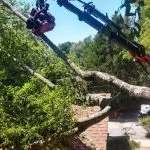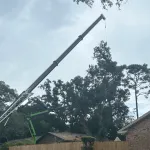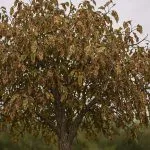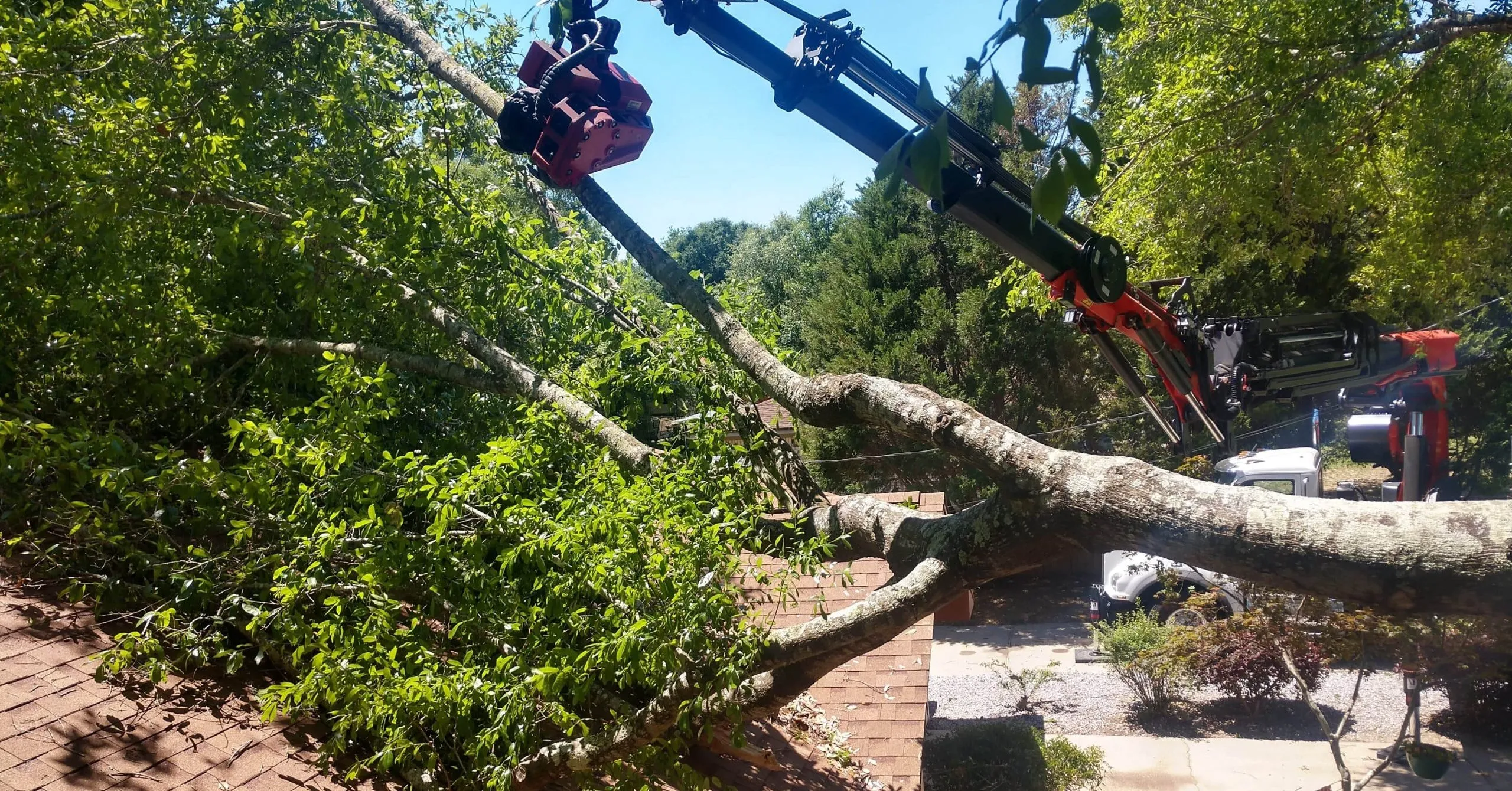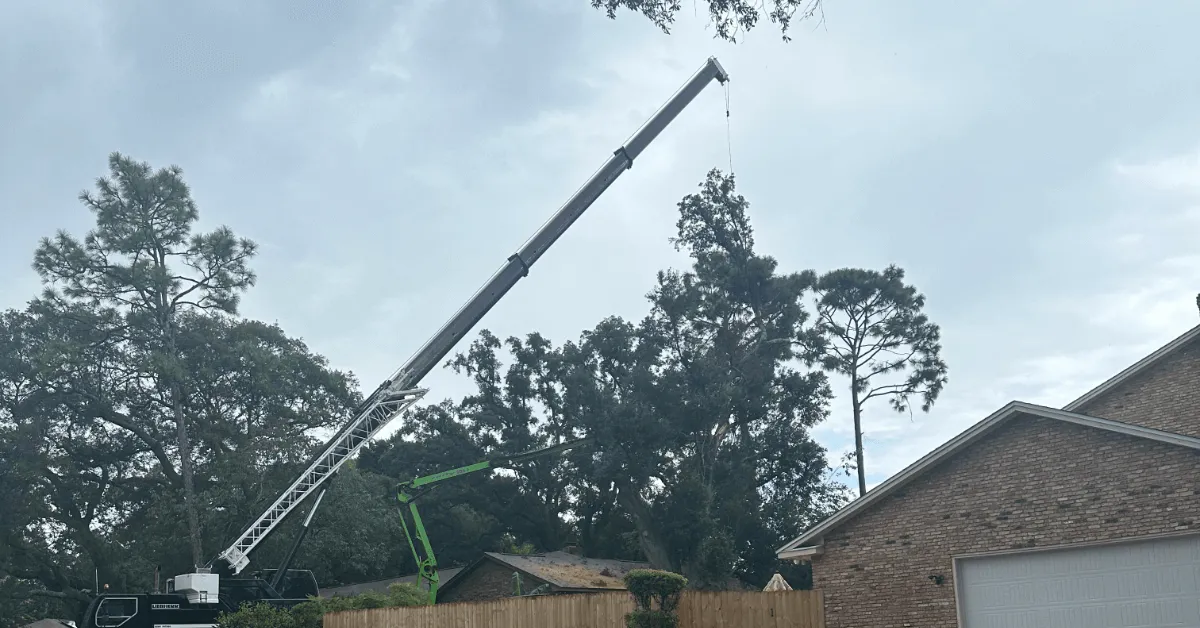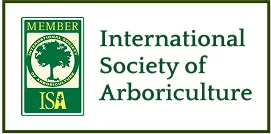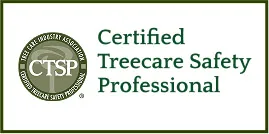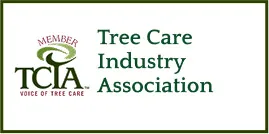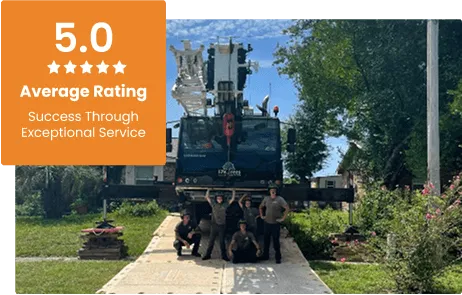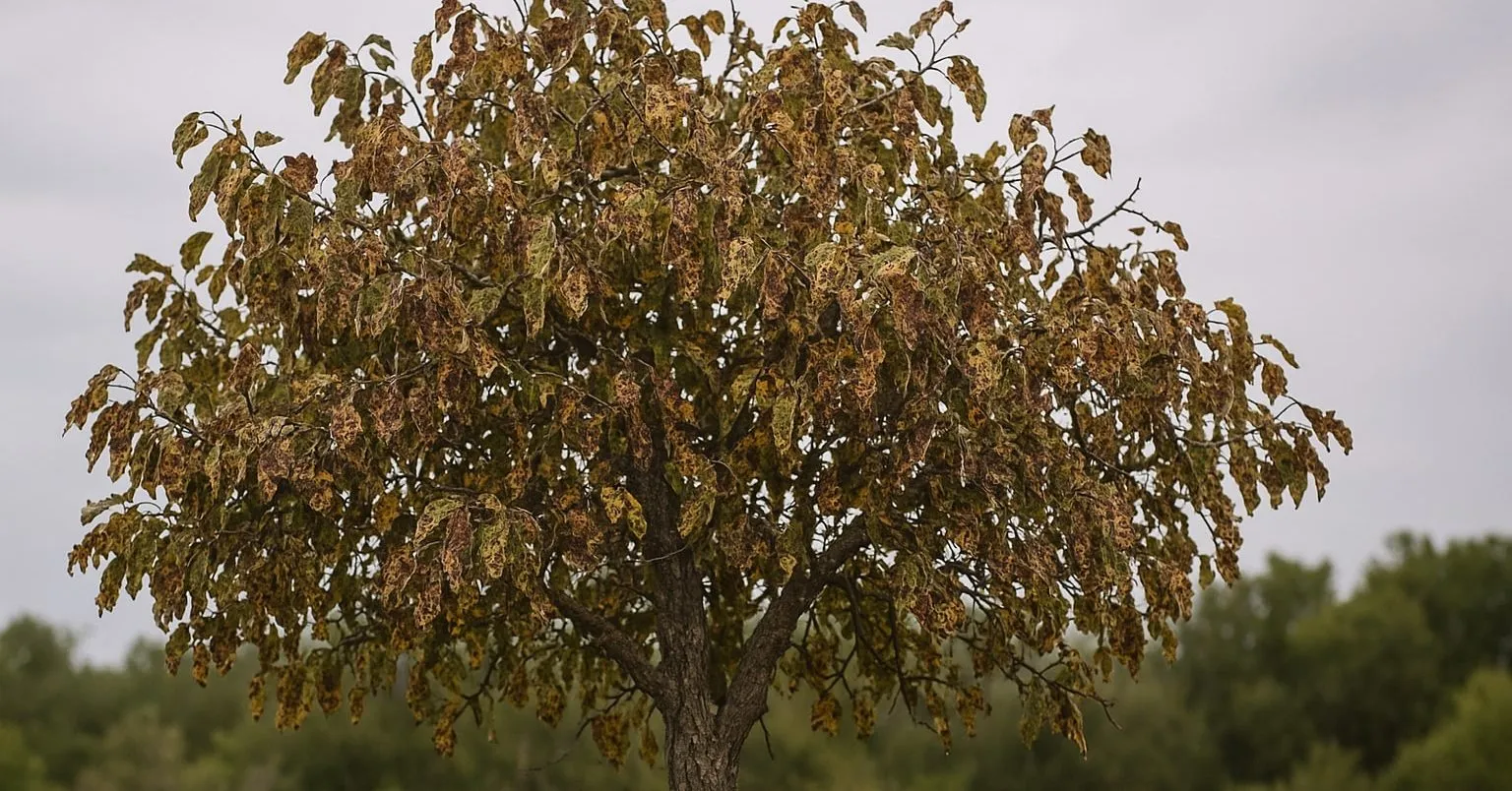
October 10, 2025
If your trees are thinning, dropping leaves too early, or developing cracks and fungus, you may be looking at more than seasonal stress. These are early warning signs that your tree could be sick, dying, or structurally unsound. Problems like internal decay, root damage, and pest infestation often start quietly before they become a safety issue.
In Pace, Pensacola, and nearby areas of Escambia and Santa Rosa Counties, removing or heavily pruning a tree often requires a permit. However, when a tree is documented as diseased, dying, or hazardous, removal is typically approved faster. That is why an inspection by an ISA-certified arborist is not only smart but often required. It helps confirm whether the tree can be treated, stabilized, or needs to be removed safely and legally.
Common Signs a Tree Is Sick
Healthy trees have full canopies, tight bark, and strong structure from root to crown. When those characteristics begin to change, it’s often the first sign that something deeper is wrong. Most trees decline slowly, and small visual clues are the earliest warning that disease, rot, or structural instability may be developing beneath the surface.
- Leaf loss or browning: When a tree sheds leaves during the growing season or evergreens start browning from the tips inward, it usually means the tree is under stress. Drought, poor drainage, pest infestations, or root rot can all cause this. If nearby trees are green and full while one appears thin or discolored, that contrast is a clear indicator of decline.
- Cracked or peeling bark: Bark protects a tree like skin protects the body. When it begins peeling in large sheets, cracking deeply, or forming soft or sunken patches, the underlying wood may already be decaying. This often happens after temperature extremes, storm injury, or fungal infection. Once bark begins separating from the trunk, internal decay accelerates quickly.
- Mushrooms or fungi: Fungal growth on the trunk, base, or around the roots is one of the most reliable signs of internal decay. Mushrooms, conks, or shelf fungi feed on rotting wood inside the tree. Even if the canopy looks healthy, the structure beneath could be severely weakened. Left untreated, these infections can spread to nearby trees and create serious fall hazards.
- Dead or hanging branches: Large limbs that are dry, brittle, or hanging loosely are high-risk hazards. These often develop after repeated storm damage or insect infestation. Even small branches can weigh enough to cause injury or property damage when they fall unexpectedly. Regular pruning by a professional helps remove these before they become dangerous.
- Leaning or shifting soil: A tree that suddenly tilts or shows cracked and raised soil around its base likely has root failure. This can happen after prolonged rainfall, high winds, or erosion. When roots lose their grip in the soil, the entire tree becomes unstable. A leaning tree near a home or power line should be evaluated immediately.
- Root or trunk injury: Damage from lawn equipment, vehicles, or construction around the base of a tree can lead to slow decline years later. Roots that are cut or compacted lose their ability to take in water and nutrients, while wounds on the trunk create easy entry points for decay fungi. These hidden injuries often go unnoticed until the tree starts showing surface symptoms like thinning foliage or fungus growth.
If your tree shows several of these warning signs, don’t wait for it to worsen. A professional inspection from an ISA-certified arborist can determine how advanced the damage is and whether the tree can be treated, stabilized, or needs to be removed for safety.
How to Check at Home (Safely)
You can do a few quick checks before calling an arborist:
- Compare foliage: If one tree is sparse or browning while others nearby are healthy, note it as an early warning sign.
- Inspect the bark: Look for peeling layers, cracks, or dark streaks that may indicate rot.
- Look for mushrooms: Fungi at the base or along the trunk often point to internal decay.
- Check the crown: Stand back and observe the canopy. Dead branches or thin foliage can signal decline.
- Examine the roots: If the soil looks lifted or cracked, or if the tree is leaning more than before, it could be unstable.
- Test a twig: Scratch a small twig. If the wood underneath is green, it is alive. If it is brown and brittle, that section is dead.
Be cautious when inspecting. Avoid standing under hanging limbs or leaning trunks.
Why Ignoring a Sick or Rotting Tree Is Riskier Than You Think
A sick tree is more than just an eyesore – it is an unpredictable hazard. In the Gulf Coast climate of Pensacola and Pace, heat, salt exposure, and high humidity accelerate how quickly rot spreads through weakened wood. What starts as a few dead branches or minor bark peeling can quickly evolve into a structural collapse, especially after heavy rain or wind.
When the inner core of a tree begins to rot, its strength drops dramatically, even if the outside still looks solid. That is why many homeowners are caught off guard when a seemingly healthy tree falls during a storm. Inside, decay quietly hollows out the trunk and roots until the tree can no longer hold its own weight.
Rotting trees also attract insects and pests such as termites, carpenter ants, and beetles. These pests speed up decay and can eventually migrate to fences, decks, or even the house foundation. In densely wooded or suburban areas like Pace, that creates a chain reaction – one failing tree can easily spread disease or infestation to others nearby.
Once decay reaches the roots or lower trunk, there is usually no reversing it. At that stage, even pruning or cabling cannot restore stability. That is why certified arborists stress early diagnosis. The sooner decay is found, the more options you have to treat, reinforce, or safely remove the tree before it becomes a liability.
Ignoring a rotting tree can lead to costly damage, safety risks, and even permit complications if failure causes harm to neighboring properties. A timely inspection can prevent that entire scenario and protect both your landscape and your peace of mind.
When to Call an ISA-Certified Arborist
Contact a certified arborist as soon as you see multiple warning signs or if your tree is near your home, driveway, or utility lines. Professionals use tiered risk assessments to measure structural safety and health. Depending on findings, they may recommend pruning, cabling, bracing, treatment, or full removal.
An ISA-certified arborist also helps you understand local permit requirements. In many cases, their written documentation can speed up city approval for hazardous tree removal.
Should You Treat, Prune, Brace, or Remove the Tree?
Every tree is different. The right approach depends on its condition and risk level.
- Treat: Some fungal and pest issues can be controlled if caught early.
- Prune: Removing dead or broken limbs prevents further decay and reduces hazards.
- Brace or cable: When a tree has a weak structure but solid roots, cabling can stabilize it.
- Remove: If the tree is leaning, decaying, or split, removal is often the only safe option.
An arborist will guide you through what can realistically be saved and what should be taken down before it becomes dangerous.
Why Trees Decline in Northwest Florida
Northwest Florida’s coastal environment makes trees vulnerable to stress from several factors:
- Storm damage: High winds and soaked soil loosen root systems and break branches.
- Construction impact: Excavation, trenching, or heavy machinery compact the soil and cut roots.
- Diseases and pests: Fungal infections, cankers, and borers spread quickly through humid conditions and injured bark.
Even healthy trees can weaken over time without proper care. Regular inspections help catch issues before they turn into emergencies.
Next Steps for Homeowners in Pace and Pensacola
- Take photos of bark damage, fungi, dead branches, or leaning.
- Schedule an ISA-certified inspection to determine risk level and next actions.
- Apply for a permit early if removal is needed. Documentation from a certified arborist can speed approval.
Frequently Asked Questions (FAQs)
What is the easiest way to tell if a tree is dead or dying?
Start by scratching a small twig or branch. If the inner layer is green and moist, that section is alive, but if it’s dry or brown, the branch is dead. Check several branches since trees can die in parts. Other signs like peeling bark, thinning leaves, and fungi growth confirm decline and mean it’s time to call an arborist.
Are mushrooms or fungi growing at the base always bad?
Yes, in most cases they are. Mushrooms or conks on the trunk or roots indicate that internal wood is decomposing. Once visible fungi appear, structural decay is already advanced, even if the canopy looks full. The safest option is to have an ISA-certified arborist inspect the tree for hidden rot.
How do I know if my evergreen is stressed or diseased?
A small amount of inner needle shedding is normal, but widespread browning or dieback is not. If entire sections of the tree are turning brown, it may have root rot, poor drainage, or salt stress from coastal air. Compare it to nearby evergreens for reference. Early treatment can often reverse decline if caught quickly.
Is peeling bark always a sign of disease?
Some species naturally shed bark, like river birch, but not all do. When bark peels in large pieces, feels soft underneath, or exposes discolored wood, the tree is likely stressed or decaying. Peeling combined with cracks or cankers often points to fungal infection. An arborist can determine whether the bark loss is natural or a sign of deeper issues.
What should I do if my tree suddenly starts leaning after a storm?
A new lean is a serious warning sign that roots may have loosened or failed. Avoid standing near the tree, as it could fall without notice. Heavy rains and wind in Pensacola’s climate can cause hidden root plate shifts. Contact an emergency tree service right away for a safety inspection.
Can pruning save a sick tree?
It depends on the cause of the decline. If the problem is limited to dead or broken limbs, pruning can help restore airflow and health. However, if decay has reached the trunk or roots, pruning won’t fix structural weakness. A certified arborist can recommend whether treatment, cabling, or removal is safest.
Do I need a permit to remove a sick tree in Pace and Pensacola?
Yes, most tree removals in Pensacola require a city permit. The process is usually faster when the tree is proven dead, dying, or hazardous with an arborist’s report. Permits protect homeowners from fines and help ensure replanting compliance. Our team assists with inspections and paperwork to make it easier.
Could construction from last year be why my tree is declining now?
Yes, it often takes months or years for damage to appear. Root cutting, soil compaction, and grade changes reduce a tree’s access to water and oxygen. Over time, that stress causes canopy thinning and decay. An arborist can perform a root collar exam to evaluate how much damage occurred.
Is it safe to remove a tree myself?
No, DIY tree removal is extremely dangerous and often leads to injury or property damage. Trees with internal decay can fall unpredictably, even if they look solid. Professionals use cranes, rigging, and protective gear to control each cut safely. Always hire a licensed, insured tree service to handle removals.
How urgent is it to remove a hanging or broken limb over my driveway or roof?
Very urgent. Hanging or cracked limbs can fall at any moment, even in mild wind. They pose a serious risk to vehicles, roofs, and anyone nearby. Schedule professional removal immediately to prevent injury or costly damage.
How D’s Trees Can Help
D’s Trees provides professional arborist services across Pace, Pensacola, and Northwest Florida. Our ISA-certified experts handle tree health assessments, pruning, cabling, bracing, crane removals, and emergency storm response. We also assist with city permits and documentation for hazardous or dying trees.
If you suspect your tree is sick or unsafe, contact us for a professional evaluation. We’ll help you choose the safest, most cost-effective solution for your property.

